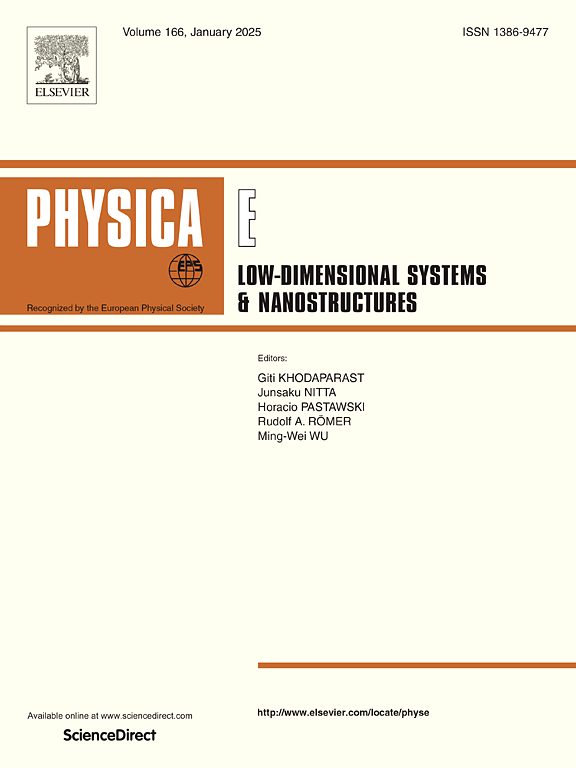Effect of Stone–Wales defect on the electronic and thermoelectric properties of armchair edge germanene nanoribbons
IF 2.9
3区 物理与天体物理
Q3 NANOSCIENCE & NANOTECHNOLOGY
Physica E-low-dimensional Systems & Nanostructures
Pub Date : 2025-02-01
DOI:10.1016/j.physe.2024.116169
引用次数: 0
Abstract
The electronic and thermoelectric properties of germanene armchair-edge nanoribbons (GeNRs) with Stone–Wales (SW) defects are comprehensively investigated. By computing the band structures for nanoribbons of varying widths (N = 5, 6, and 7), I observe that SW defects can modulate the electronic properties, particularly the bandgap, in a width-dependent manner. The density of states (DOS) and transmission function analyses confirm these changes, showing that SW defects introduce scattering centers that affect charge carrier mobility. The voltage-current characteristics reveal a negative differential resistance (NDR) phenomenon in SW-defected GeNRs, indicating potential applications in non-linear electronic devices. Furthermore, the thermoelectric properties, as assessed by the Seebeck coefficient (S) and electronic figure of merit (ZTe), show that SW defects can significantly enhance the ZTe value, particularly for the N = 6 width, where ZTe increases by approximately three times. These findings underscore the potential of SW defects to tailor the electronic and thermoelectric properties of germanene nanoribbons for specific applications.
求助全文
约1分钟内获得全文
求助全文
来源期刊
CiteScore
7.30
自引率
6.10%
发文量
356
审稿时长
65 days
期刊介绍:
Physica E: Low-dimensional systems and nanostructures contains papers and invited review articles on the fundamental and applied aspects of physics in low-dimensional electron systems, in semiconductor heterostructures, oxide interfaces, quantum wells and superlattices, quantum wires and dots, novel quantum states of matter such as topological insulators, and Weyl semimetals.
Both theoretical and experimental contributions are invited. Topics suitable for publication in this journal include spin related phenomena, optical and transport properties, many-body effects, integer and fractional quantum Hall effects, quantum spin Hall effect, single electron effects and devices, Majorana fermions, and other novel phenomena.
Keywords:
• topological insulators/superconductors, majorana fermions, Wyel semimetals;
• quantum and neuromorphic computing/quantum information physics and devices based on low dimensional systems;
• layered superconductivity, low dimensional systems with superconducting proximity effect;
• 2D materials such as transition metal dichalcogenides;
• oxide heterostructures including ZnO, SrTiO3 etc;
• carbon nanostructures (graphene, carbon nanotubes, diamond NV center, etc.)
• quantum wells and superlattices;
• quantum Hall effect, quantum spin Hall effect, quantum anomalous Hall effect;
• optical- and phonons-related phenomena;
• magnetic-semiconductor structures;
• charge/spin-, magnon-, skyrmion-, Cooper pair- and majorana fermion- transport and tunneling;
• ultra-fast nonlinear optical phenomena;
• novel devices and applications (such as high performance sensor, solar cell, etc);
• novel growth and fabrication techniques for nanostructures

 求助内容:
求助内容: 应助结果提醒方式:
应助结果提醒方式:


